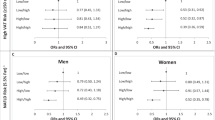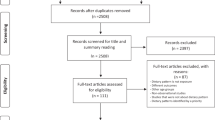Abstract
Background/Objectives:
The term ‘beer belly’ expresses the common belief that beer consumption is a major determinant of waist circumference (WC). We studied the gender-specific associations between beer consumption and WC (partially in relation to body weight and hip circumference (HC) change).
Participants/Methods:
Within the European Prospective Investigation into Cancer and Nutrition (EPIC)–Potsdam study (7876 men, 12 749 women), cross-sectional associations were investigated applying general linear models. Prospective analyses of baseline beer consumption and an 8.5-year WC change were assessed using multivariate general linear models and polytomous logistic regression. To test the site-specific effect of beer consumption on WC, an adjustment for concurrent changes in body weight and HC was carried out. In addition, the relationship between change in beer consumption and change in WC was studied.
Results:
A positive association in men and no association in women were seen between beer consumption and WC at baseline. Men consuming 1000 ml/d beer were at 17% higher risk for WC gain compared with very light consumers. Significantly lower odds for WC gain (odds ratio=0.88; 95% confidence interval 0.81, 0.96) were found in beer-abstaining women than in very-light-drinking women. The adjustment for concurrent body weight and HC change diminished effect estimates notably, explaining most of the association between beer and change in WC. Decreasing beer consumption was related to higher relative odds for WC loss, although not statistically significant.
Conclusions:
Beer consumption leads to WC gain, which is closely related to concurrent overall weight gain. This study does not support the common belief of a site-specific effect of beer on the abdomen, the beer belly.
This is a preview of subscription content, access via your institution
Access options
Subscribe to this journal
Receive 12 print issues and online access
$259.00 per year
only $21.58 per issue
Buy this article
- Purchase on Springer Link
- Instant access to full article PDF
Prices may be subject to local taxes which are calculated during checkout

Similar content being viewed by others
References
Bjorntorp P (2001). Do stress reactions cause abdominal obesity and comorbidities? Obes Rev 2, 73–86.
Bobak M, Skodova Z, Marmot M (2003). Beer and obesity: a cross-sectional study. Eur J Clin Nutr 57, 1250–1253.
Bohlscheid-Thomas S, Hoting I, Boeing H, Wahrendorf J (1997). Reproducibility and relative validity of food group intake in a food frequency questionnaire developed for the German part of the EPIC project. European Prospective Investigation into Cancer and Nutrition. Int J Epidemiol 26 (Suppl 1), S59–S70.
Dallongeville J, Marecaux N, Ducimetiere P, Ferrieres J, Arveiler D, Bingham A et al. (1998). Influence of alcohol consumption and various beverages on waist girth and waist-to-hip ratio in a sample of French men and women. Int J Obes Relat Metab Disord 22, 1178–1183.
Duncan BB, Chambless LE, Schmidt MI, Folsom AR, Szklo M, Crouse 3rd JR et al. (1995). Association of the waist-to-hip ratio is different with wine than with beer or hard liquor consumption. Atherosclerosis Risk in Communities Study Investigators. Am J Epidemiol 142, 1034–1038.
Eck LH, Pascale RW, Klesges RC, Ray JA, Klesges LM (1995). Predictors of waist circumference change in healthy young adults. Int J Obes Relat Metab Disord 19, 765–769.
Haftenberger M, Lahmann PH, Panico S, Gonzalez CA, Seidell JC, Boeing H et al. (2002). Overweight, obesity and fat distribution in 50- to 64-year-old participants in the European Prospective Investigation into Cancer and Nutrition (EPIC). Public Health Nutr 5, 1147–1162.
Halkjaer J, Sorensen TI, Tjonneland A, Togo P, Holst C, Heitmann BL (2004). Food and drinking patterns as predictors of 6-year BMI-adjusted changes in waist circumference. Br J Nutr 92, 735–748.
Halkjaer J, Tjonneland A, Thomsen BL, Overvad K, Sorensen TI (2006). Intake of macronutrients as predictors of 5-y changes in waist circumference. Am J Clin Nutr 84, 789–797.
Jequier E (1999). Alcohol intake and body weight: a paradox. Am J Clin Nutr 69, 173–174.
Kahn HS, Tatham LM, Heath Jr CW (1997). Contrasting factors associated with abdominal and peripheral weight gain among adult women. Int J Obes Relat Metab Disord 21, 903–911.
Klesges RC, Mealer CZ, Klesges LM (1994). Effects of alcohol intake on resting energy expenditure in young women social drinkers. Am J Clin Nutr 59, 805–809.
Koh-Banerjee P, Chu NF, Spiegelman D, Rosner B, Colditz G, Willett W et al. (2003). Prospective study of the association of changes in dietary intake, physical activity, alcohol consumption, and smoking with 9-y gain in waist circumference among 16 587 US men. Am J Clin Nutr 78, 719–727.
Koppes LL, Twisk JW, Van Mechelen W, Snel J, Kemper HC (2005). Cross-sectional and longitudinal relationships between alcohol consumption and lipids, blood pressure and body weight indices. J Stud Alcohol 66, 713–721.
Lukasiewicz E, Mennen LI, Bertrais S, Arnault N, Preziosi P, Galan P et al. (2005). Alcohol intake in relation to body mass index and waist-to-hip ratio: the importance of type of alcoholic beverage. Public Health Nutr 8, 315–320.
McCarty MF (1999). The alcohol paradox. Am J Clin Nutr 70, 940–942.
Riboli E, Hunt KJ, Slimani N, Ferrari P, Norat T, Fahey M et al. (2002). European Prospective Investigation into Cancer and Nutrition (EPIC): study populations and data collection. Public Health Nutr 5, 1113–1124.
Riserus U, Ingelsson E (2007). Alcohol intake, insulin resistance, and abdominal obesity in elderly men. Obesity (Silver Spring) 15, 1766–1773.
Rosmond R, Bjorntorp P (1999). Psychosocial and socio-economic factors in women and their relationship to obesity and regional body fat distribution. Int J Obes Relat Metab Disord 23, 138–145.
Sherwood NE, Jeffery RW, French SA, Hannan PJ, Murray DM (2000). Predictors of weight gain in the Pound of Prevention study. Int J Obes Relat Metab Disord 24, 395–403.
Shimokata H, Muller DC, Andres R (1989). Studies in the distribution of body fat III. Effects of cigarette smoking. JAMA 261, 1169–1173.
Slattery ML, McDonald A, Bild DE, Caan BJ, Hilner JE, Jacobs Jr DR. et al. (1992). Associations of body fat and its distribution with dietary intake, physical activity, alcohol, and smoking in blacks and whites. Am J Clin Nutr 55, 943–949.
Souci SW, Fachmann W, Kraut H (2000). Food Composition and Nutrition Tables. 6th ed. Stuttgart: Medpharm.
Statistisches Bundesamt Deutschland (2007). Entwicklung des Bierverbrauchs in Deutschland seit 1997. Wiesbaden.
Vadstrup ES, Petersen L, Sorensen TI, Gronbaek M (2003). Waist circumference in relation to history of amount and type of alcohol: results from the copenhagen city heart study. Int J Obes Relat Metab Disord 27, 238–246.
Vernay M, Balkau B, Moreau JG, Sigalas J, Chesnier MC, Ducimetiere P (2004). Alcohol consumption and insulin resistance syndrome parameters: associations and evolutions in a longitudinal analysis of the French DESIR cohort. Ann Epidemiol 14, 209–214.
Wannamethee SG, Field AE, Colditz GA, Rimm EB (2004). Alcohol intake and 8-year weight gain in women: a prospective study. Obes Res 12, 1386–1396.
Wannamethee SG, Shaper AG (1997). Lifelong teetotallers, ex-drinkers and drinkers: mortality and the incidence of major coronary heart disease events in middle-aged British men. Int J Epidemiol 26, 523–531.
Wannamethee SG, Shaper AG (2003). Alcohol, body weight, and weight gain in middle-aged men. Am J Clin Nutr 77, 1312–1317.
Wannamethee SG, Shaper AG, Whincup PH (2005). Alcohol and adiposity: effects of quantity and type of drink and time relation with meals. Int J Obes (Lond) 29, 1436–1444.
Acknowledgements
The EPIC–Potsdam study was supported by grants from German Cancer Aid, from the German Federal Ministry of Education and Research and the European Union.
Author information
Authors and Affiliations
Corresponding author
Additional information
Contributors: MS, AK, HB and MS were responsible for the study design, concept and idea of the analysis. Data analysis and interpretation of the data was done by MS, HB and MS. The manuscript was drafted by MS and HB. All authors were involved into interpretation of the study results, critical review of the manuscript and contributed significantly to the content of the manuscript.
Rights and permissions
About this article
Cite this article
Schütze, M., Schulz, M., Steffen, A. et al. Beer consumption and the ‘beer belly’: scientific basis or common belief?. Eur J Clin Nutr 63, 1143–1149 (2009). https://doi.org/10.1038/ejcn.2009.39
Received:
Revised:
Accepted:
Published:
Issue Date:
DOI: https://doi.org/10.1038/ejcn.2009.39
Keywords
This article is cited by
-
Adolescent wine consumption is inversely associated with long-term weight gain: results from follow-up of 20 or 22 years
Nutrition Journal (2019)
-
Alcohol and Hypertension—New Insights and Lingering Controversies
Current Hypertension Reports (2019)
-
Alcohol consumption is associated with DXA measurement of adiposity: the Pró-Saúde Study, Brazil
European Journal of Nutrition (2017)
-
Alcohol Consumption and Obesity: An Update
Current Obesity Reports (2015)
-
Alcohol and macronutrient intake patterns are related to general and central adiposity
European Journal of Clinical Nutrition (2012)



